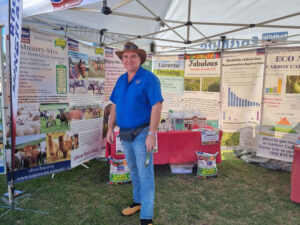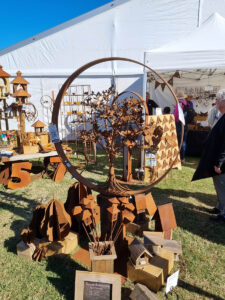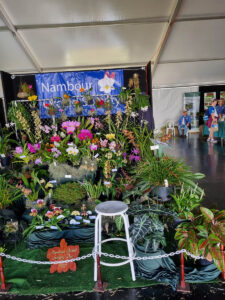All in the soil
By Patrick Regnault
The Queensland Garden Expo took place recently in Nambour. Once again it attracted a very good crowd of seasoned and new gardeners, all intending to obtain quality plants from growers, and reliable information from speakers as well as the Horticultural Media Association Australia (HMAA) Garden Clinic. Plant stalls were numerous with a very large selection ranging from edibles to native and exotic, garden and indoor plants as well as some collectors items. Tools, small and large, were the feature of many stands as well as garden ornamentation and landscape materials. Fertilisers and soils were present and I noticed a positive shift towards restoring soil biology as the main focus of many exhibitors and speakers.

Plant nutrition relies on a healthy soil food web balance. Hopefully the days of just chucking compost and fertilisers on the soil to fix imbalances in plants is coming to an end. A balanced soil allows plants to grow a deeper and stronger root system making them more efficient at securing food and more resilient to changing conditions.
I had a long and fruitful chat with horticulturist Colin Johnson about fertilisers and soil improvers. I asked Colin ‘which is the most misunderstood fertiliser’ and he responded with “rock dust or volcanic rock minerals due to very sparse information, especially in Australia, and the insufficient teaching on the subject in horticulture studies”, but mostly he was much more focused on restoring the microbial life in the soil.
Soil disturbance and loss of top soil is unbalancing the natural soil fauna and flora. Many gardens, and even acreages, have lost soil fertility and structure due to earthworks or misuse of the land over long periods. Adding compost or even rock minerals helps to a point but it is slow and not always available to plants due to the lack of soil biology, and allows only a small range of bacteria and fungi to recolonise over time. Recharging the soil with a broad spectrum bacterial and fungal inoculant helps to speed up the process and improve its fertility, nutrient intake, soil structure, and overall biodiversity.

Colin’s own place is an example of practising what you preach. His property is part of the Land For Wildlife scheme and he has noticed that as his soil biology improved so did the number of species of birds and mammals. A good ecosystem is the collaboration, interaction and the interdependence of many and diverse species. The healthy soil food web is what allows that to occur. A balanced soil contains a wide range of micro-organisms. It is now well understood that the rhizosphere microbiome could contain disease-suppressive bacteria thus helping plants to combat pathogens.
There are many ways to stimulate soil biodiversity. Mulches act as a biostimulant, but to be effective we need to vary the mulches we use. I suggest that when the time comes to refresh the garden with a new layer of mulch, use a different one. Varying the type of mulch allows different micro-organisms to develop and increases their diversity.

Straw mulch can be unsightly but its effect on soil organisms is quite extraordinary; barley and soybean straws seem to be the best to help the soil biomass. Humic and fulvic acids provide a carbon food source rapidly available to microorganisms. Seaweed extract acts on soil moisture retention and improves root development, which in turn helps create a better environment for fungi and bacteria.
When planting, keep in mind the root system of plants; the more diverse in types and reach, vertically or horizontally, the more helpful it will be to help create a diverse soil biomass.
A sentence Colin Johnson read a long time ago in a soil science book stuck with him; “The more energy there is within a system, the more life there is”. Soil biology is a very dynamic part of the life cycle, an energy creator.
I will end with this sentence from Colin: “At its core, what we are about as horticulturists and gardeners, is life”.
Patrick Regnault FAIH RH0062
Interactive Landscapes
Main photo: Display of the Nambour Orchid Society (Image: Patrick Regnault)

